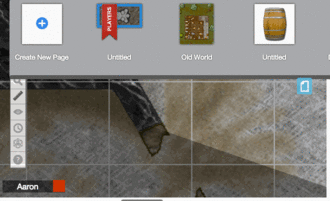Difference between revisions of "Page Toolbar"
From Roll20 Wiki
(→Split the Party: Adding animated example) |
m (Added Duplicate Page Settings) |
||
| Line 19: | Line 19: | ||
Note that is entirely possible that the GM and the players can be on a different page, so you can be constructing the next encounter while your players are still on a previous page. | Note that is entirely possible that the GM and the players can be on a different page, so you can be constructing the next encounter while your players are still on a previous page. | ||
| + | |||
| + | == Duplicate Page Settings == | ||
| + | The Duplicate Page button will create a new page with the identical settings of the source page, but with none of the contents. This allows you to create a page with the movement options, scale, grid, etc all set the way you want it, and then add more pages with the same settings. | ||
== Moving Tokens Between Pages == | == Moving Tokens Between Pages == | ||
Revision as of 19:30, 12 May 2015
In Roll20, a campaign is comprised of multiple Pages, like the pages from a storybook or the scenes in a storyboard. Each page represents an encounter, an NPC, an overland map, or some other discrete piece of the campaign. You can only view one page at a time.
Contents[hide] |
Managing Pages
You manage the pages of your Campaign by clicking on the Page Toolbar button in the top right-hand side of the screen (a blue button with a white icon of a page). The toolbar shows you all the pages currently in your campaign. You can drag and drop the pages to re-order them, or click on the name of the page to edit the name.
If you hover over a page you'll also see two new buttons appear, one (a gear icon) for accessing the Page Settings dialog box, and the other (a red X) for deleting the page.
To create a new page, just click on the "Create New Page" button on the left-hand side of the Page Toolbar. Change the page's name by clicking on the name under the page's icon. Enter the new name and press Enter/Return to save.
Switching Between Pages
The GM can quickly switch between pages at any time by accessing the Page Toolbar and clicking on the page that they want to switch to. There will be a short loading sequence and the selected page will be displayed.
The players will see whichever page you place the Player Bookmark on. The Player Bookmark is a red ribbon with the word "Players" on it. You can click and drag to move it between pages, thus moving the players to that new page.
Note that is entirely possible that the GM and the players can be on a different page, so you can be constructing the next encounter while your players are still on a previous page.
Duplicate Page Settings
The Duplicate Page button will create a new page with the identical settings of the source page, but with none of the contents. This allows you to create a page with the movement options, scale, grid, etc all set the way you want it, and then add more pages with the same settings.
Moving Tokens Between Pages
Sometimes you will want to move objects (such as tokens representing the players) between pages. To do so, just select the tokens, then press Ctrl+C (or Cmd+C on Mac) to copy them. Switch to the new page, then press Ctrl+V (or Cmd+V) to paste them onto the new page. The location that token will paste to is oriented from the last time you clicked on the tabletop.
Split the Party
Just drag-and-drop the "player" from the player area at the bottom of your screen, onto a page in the page toolbar at the top (while the toolbar is open). That will create a little icon for that player to show what page they are on. Drag and drop it onto a different page to switch that player between pages, or drag it back to the Player Bookmark to "reset" that player back to using the normal player bookmark ('rejoining the group', essentially).
How To
Page Settings
There are a number of settings that you can change for each page, including the type of grid, enabling Fog of War, and more. For more details, consult the Page Settings help guide.












